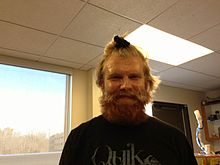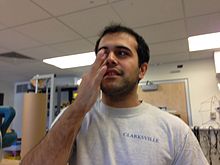PlasterMaskBase Tutorial
This guide outlines how to create the plaster base of a mask.
To create the mask, you will need petroleum jelly (any brand will do), plaster strips, a pair of scissors, and about a liter of hot water in a container with an open lid. The process will be messy, so make sure you are wearing work clothes that you can get dirty.
Step 1: Apply Petroleum Jelly to your face.
[edit | edit source]Add it over eyebrows, eyelids, down underneath your chin, and around your hairline.
Step 2: Apply Plaster Strips
[edit | edit source]Use the scissors to cut the plaster roll into about 1" thick strips as needed. Dip each strip into the hot water, and smooth out the strip after its dipped such that most of the holes between the threads in the strip are covered. If the strip feels hard or chalky anywhere after you have dipped it, discard it or snip off the chalky parts. As you get into smaller areas like around the nostrils or over the bridge of the nose, cut smaller strips. The wet plaster strips will readily stick together, so
Begin making the base of the mask around the outer edges working inward. Get the bottom layer of the mask on quickly, then continue to layer strips on top. Be sure to make an emphasis on the edges of the mask, since the mask will be held and handled from the outside edges and must be sturdy.
Step 3: Let Dry
[edit | edit source]The mask will take from 15 to 30 minutes to dry, depending on the thickness. To remove the mask, wiggle your eyebrows and change your expression until the mask breaks free from your skin, then carefully pull it off your face from the edge. If you feel it beginning to bend rather than come off all at once, lay it back down on your face and let it dry a bit more.
Step 4: Add Embellishments
[edit | edit source]If you want the mask to be more than just a part of your face, you will need to attach a 'exoskeleton' of material shaped in the general form of the final mask, then lay plaster strips over it just like you did with your face. You can use almost any non-toxic, light, sturdy material for the skeleton; its only purpose is to support the plaster strips as they are drying.
I hot-glued a plastic cup that I cut in half to make the snout of a crocodile half-mask. Once the plaster is laid over the cup, its impossible to tell what there is underneath.












